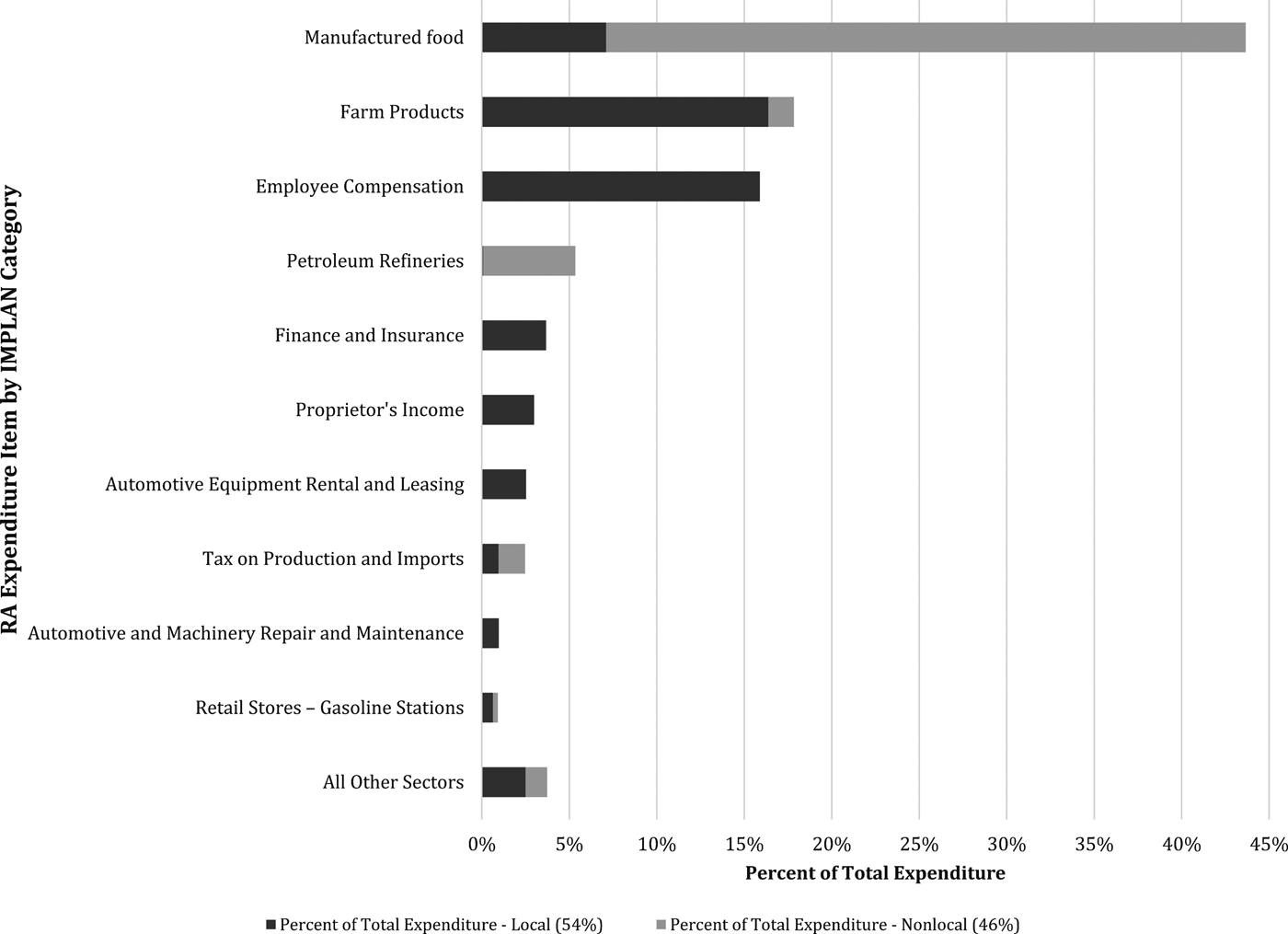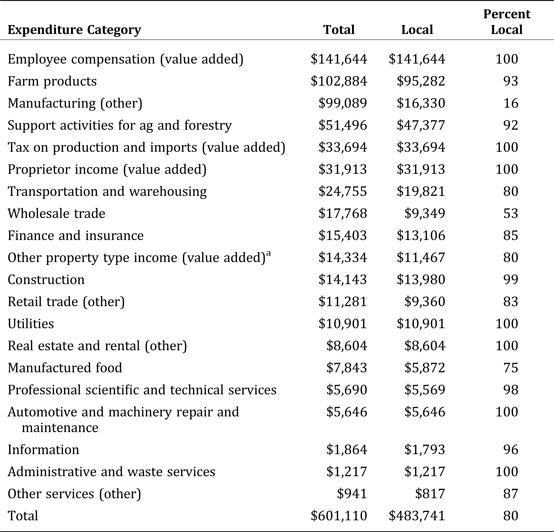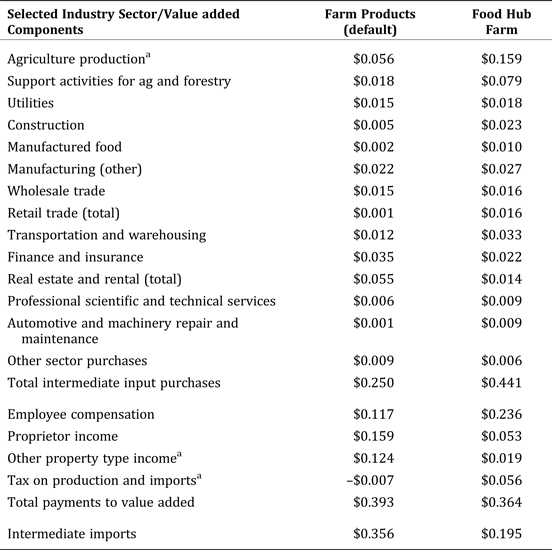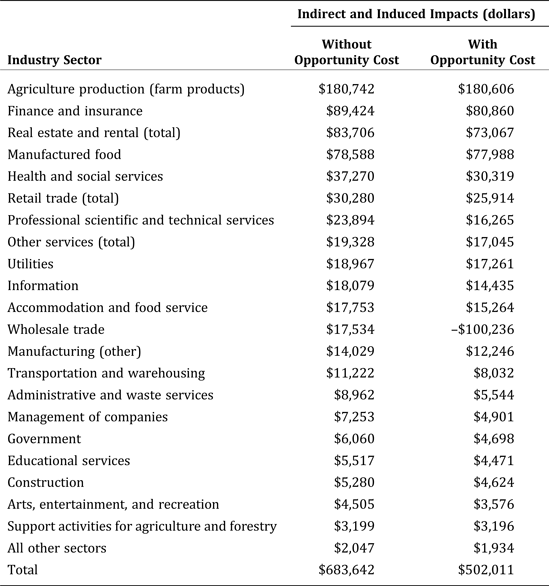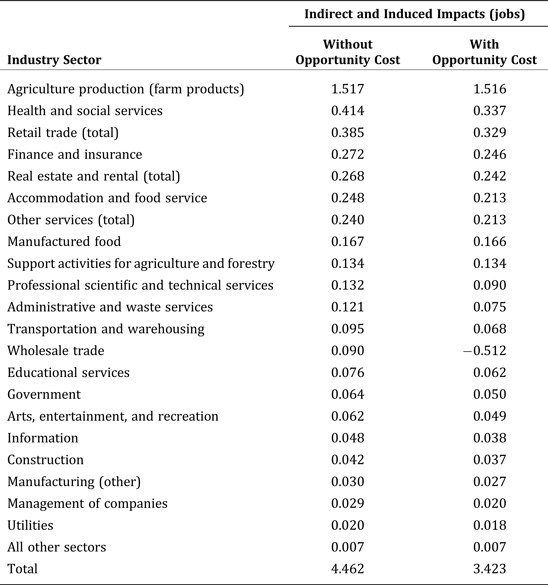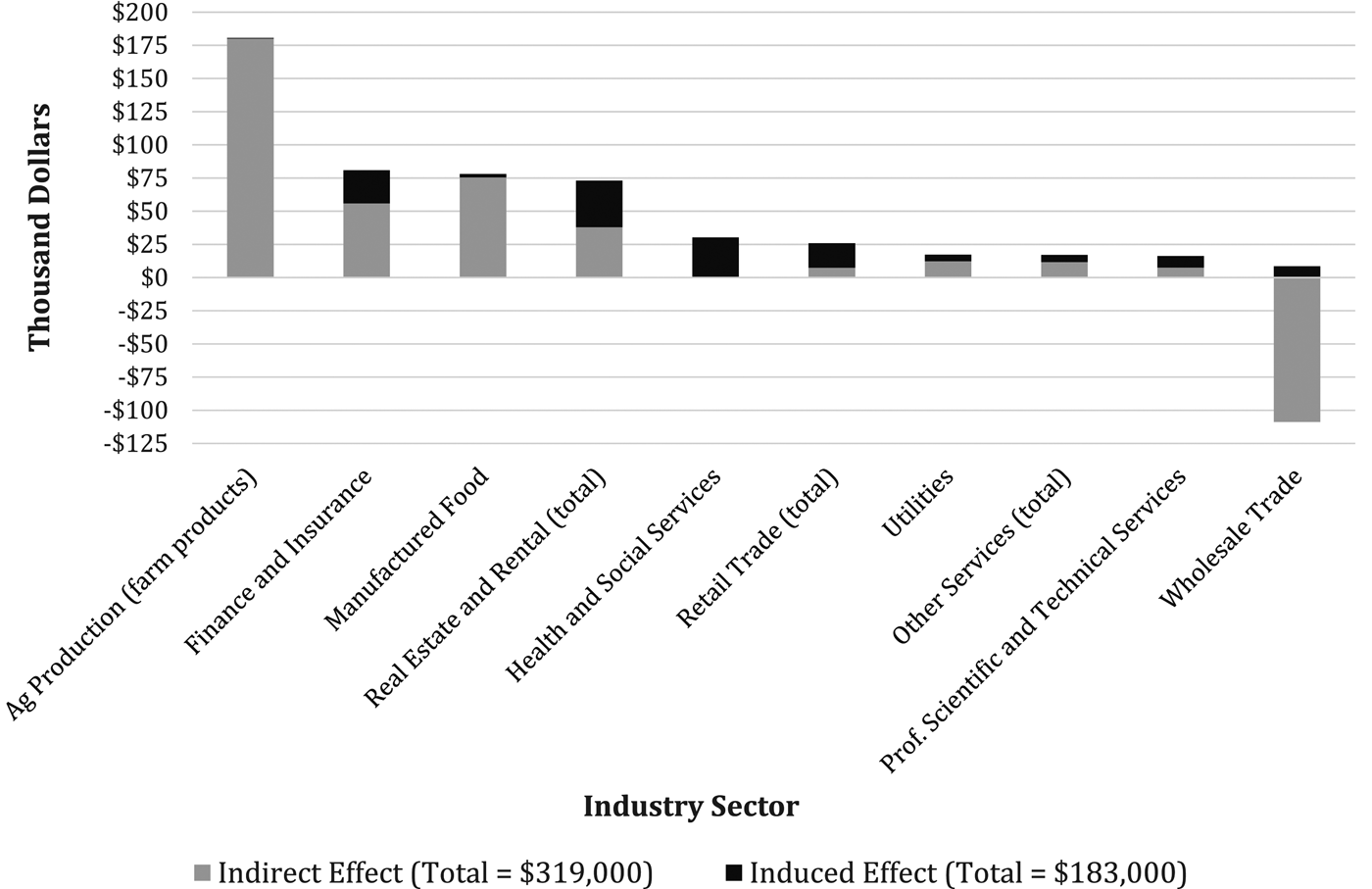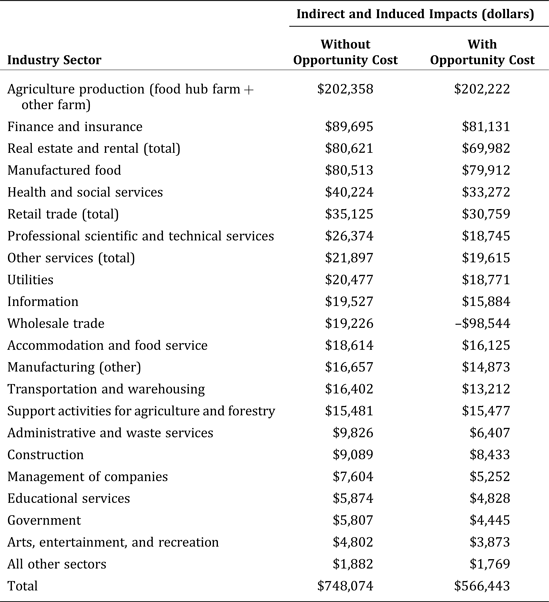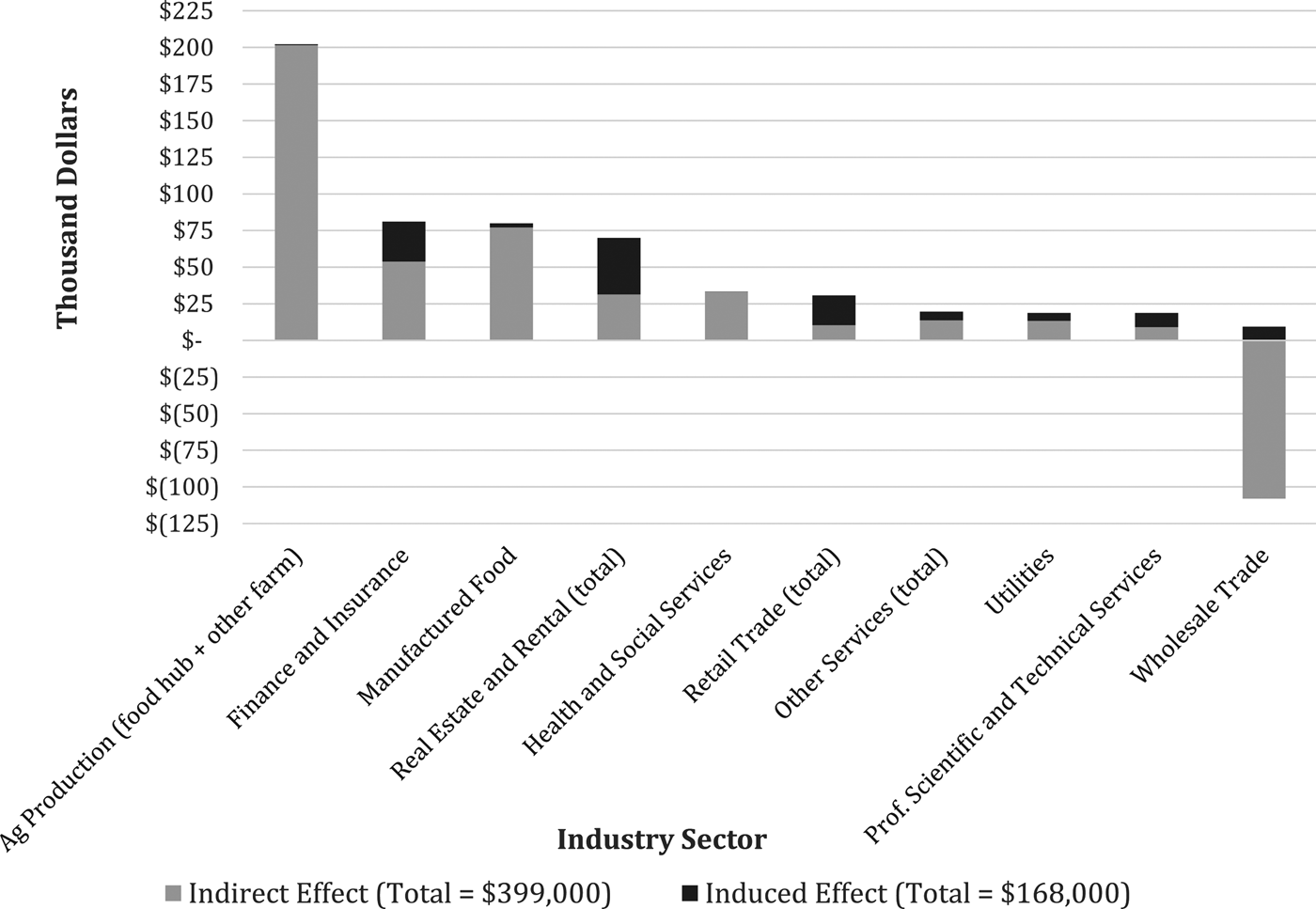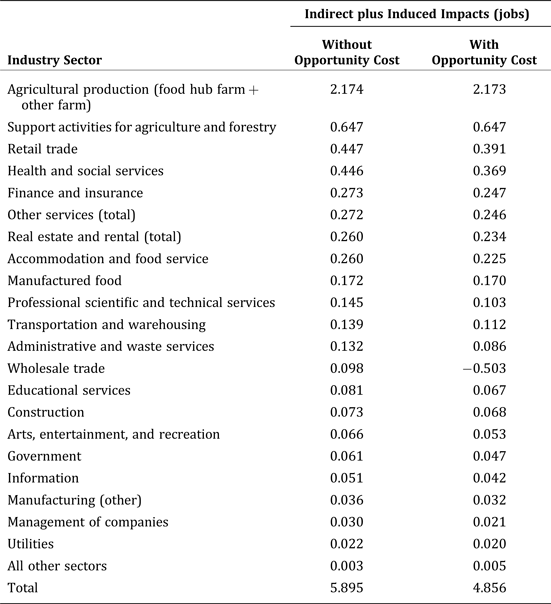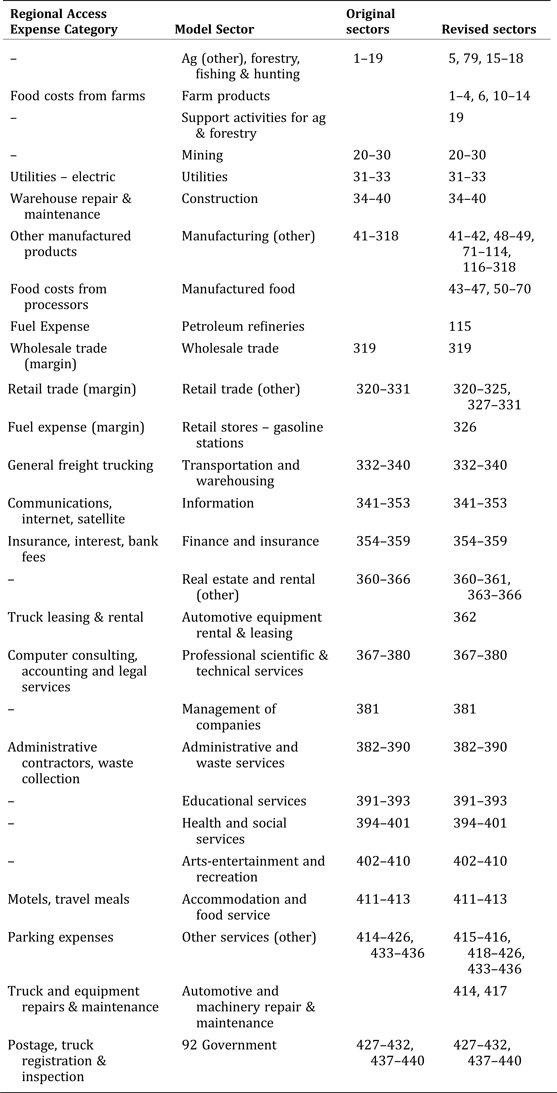As policymakers, researchers, and practitioners seek new opportunities to support rural communities and agri-businesses, interest in local food systemsFootnote 1 continues to grow (Clancy Reference Clancy2010, Jensen Reference Jensen2010, King et al. Reference King, Hand, DiGiacomo, Clancy, Gómez, Hardesty, Lev and McLaughlin2010, Low et al. Reference Low, Adalja, Beaulieu, Key, Martinez, Melton, Perez, Ralston, Stewart, Suttles, Vogel and Jablonski2015, O'Hara and Pirog Reference O'Hara and Pirog2013, National Research Committee on Twenty-first Century Systems Agriculture 2010). The role of small-scale and medium-scale producers in developing local and regional food systems has also attracted renewed attention as their importance in supplying alternative food markets has gained recognition (Low and Vogel Reference Low and Vogel2011). Despite the purported potential for local food systems to increase farm sales, particularly for small-scale and mid-scale producers, and support rural economic development, the U.S. Department of Agriculture (USDA) acknowledged a “lack of distribution systems for moving local foods into mainstream markets” (Martinez et al. Reference Martinez, Hand, DaPra, Pollack, Ralston, Smith, Vogel, Clark, Lohr, Low and Newman2010, p. iv) as posing a barrier to efforts to “scale up” local food and meet consumer demand.
Access to markets that provide positive returns on investment is increasingly difficult for small and mid-sized farms as supply chains become more vertically integrated and consolidated. Large-scale supermarket retail and wholesale operations demand large volumes, low prices, and consistent quantities and qualities that meet increasingly strict safety standards, and the procurement systems in such markets are often vertically and horizontally integrated, global in scale, and aimed at maximizing efficiency (King et al. Reference King, Hand, DiGiacomo, Clancy, Gómez, Hardesty, Lev and McLaughlin2010, Richards and Pofahl Reference Richards and Pofahl2010, Sexton Reference Sexton2010, Tropp, Ragland, and Barham Reference Tropp, Ragland and Barham2008).
In their efforts to support smaller-scale producers and foster opportunities for rural development, public agencies and private foundations are increasingly financing and promoting development of “food hubs”:
Business(es) or organization(s) that actively manage the aggregation, distribution, and marketing of source-identified food products primarily from local and regional producers to strengthen their ability to satisfy wholesale, retail, and institutional demand. (Barham et al. Reference Barham, Tropp, Enterline, Farbman, Fisk and Kiraly2012, 4)
For example, the Food Hub Collaboration is a public-private effort between USDA, the Wallace Center at Winrock International, the National Good Food Network (NGFN), the Farm Credit Council, and other organizations that work to:
Ensure the success of existing and emerging food hubs in the United States by building capacity through connection, outreach, research, technical assistance, and partnership. (NGFN 2010)
Similarly, USDA's “Know Your Farmer, Know Your Food” (KYF2) task force has established a regional subcommittee to address food hubs. That committee prepared a list in 2011 of fifteen agency programs that provided funding to support food hubs, including Rural Development, USDA's Agricultural Marketing Service (AMS), the National Institute of Food and Agriculture, the Farm Service Agency, the Natural Resources Conservation Service, and USDA's Risk Management Agency (KYF2 Regional Food Hub Subcommittee 2011).Footnote 2 Some state governments have also used public funds to support development of food hubs; for example, in February 2013 the governor of New York announced $3.6 million in state funding to support four new food hubs (Cuomo Reference Cuomo2013). As of 2013, there were more than 220 self-reported food hubs across the United States, an increase of 68 percent since 2008 (USDA 2013).
Despite this growing interest in food hubs and a burgeoning literature describing food hub development (e.g., Abatekassa and Peterson Reference Abatekassa and Peterson2011, Barham Reference Barham2011, Barham et al. Reference Barham, Fisk, Collier and Carmody2011, Clancy and Ruhf Reference Clancy and Ruhf2010, Conner et al. Reference Conner, Nowack, Berkenkamp, Feenstra, Kim, Liquori and Hamm2011, Day-Farnsworth and Morales Reference Day-Farnsworth and Morales2011, Diamond and Barham Reference Diamond and Barham2011, Feenstra et al. Reference Feenstra, Allen, Hardesty, Ohmart and Perez2011, Hardesty et al. Reference Hardesty, Feenstra, Visher, Lerman, Thilmany-McFadden, Bauman, Gillpatrick and Rainbolt2014, Jablonski, Perez-Burgos, and Gomez Reference Jablonski, Perez-Burgos and Gómez2011, Schmidt et al. Reference Schmidt and Kolodinsky2011, Stevenson and Pirog Reference Stevenson, Pirog, Lyson, Stevenson and Welsh2008), no comprehensive, data-driven assessments of the economic impact of such hubs have been completed to date. Nor is there an agreed-upon methodology for conducting such economic assessments (O'Hara and Pirog Reference O'Hara and Pirog2013).
Analyses of economic impacts model and measure the economic activity associated with the sequential effects of linked purchases. An (exogenous) final demand-driven change in food hub goods and services triggers changes in levels of production in other industry sectors in the economy. Of key importance for policy is the extent to which food hubs increase overall demand for and consumption of locally grown agricultural products versus diverting farm sales from an existing local market (e.g., a farmers’ market) to the hub. Additionally, policymakers need to understand the percentage of the sales price typically retained by the farmer from sales to a food hub versus sales to other market outlets. Policymakers’ primary interest in food hubs relates to their potential to support economic development and, in particular, to increase the viability of the local farm sector.
This analysis specifically addresses whether increases in final demand for goods and services from a food hub divert sales from other industry sectors (e.g., wholesale trade), leading to a “beggar thy neighbor” phenomenon (Boys and Hughes Reference Boys and Hughes2013, Thilmany et al. Reference Thilmany, McKenney, Mushinski and Weiler2005), or increase farm profitability. We explicitly account for where businesses would have purchased products if the food hub did not exist—or, as we define it, the opportunity cost. Attention to this type of impact can better inform public and private programs that support food hub initiatives.
Efforts to assess the impacts of local food systems are often complicated by a lack of data identifying major inter-industry sales and purchasing links among the system's participants. Those data insufficiencies are exacerbated when evaluating food hubs because the hubs are not considered to be a separate sector; inter-industry links must be identified from data on existing industry sectors in the economy.
The primary objective of this study is to demonstrate the value of a replicable methodology by which to evaluate the economic impacts of an increase in final demand for food hub goods and services on local economies and participating farms. This is accomplished by developing a data-driven empirical framework that is applicable to a variety of food hub structures. Since USDA distinguishes food hubs from other traditional food aggregators and distributors in part based on their purchases being “primarily from local and regional producers” (Barham et al. Reference Barham, Tropp, Enterline, Farbman, Fisk and Kiraly2012, p. 4), variations in the spending patterns of hubs and more traditional operations can be modeled to determine their relative effects on the regional economy, including impacts on local agricultural sectors.
We apply the resulting framework to a case study of a food hub in New York. There are limits to the ability to generalize the results of an individual case study to other food hubs, but we can use adjusted expenditure patterns in contexts in which other food hubs exhibit similar attributes (i.e., perform similar types of business functions and/or serve a similar number of farms or similarly scaled markets). When food hubs are more dissimilar in terms of activities and purchasing and sales patterns, a more comprehensive data set is advised.
Our secondary objective is to better understand the extent to which food hubs increase overall demand for and consumption of local food products. We collect additional information on the nature of purchases of outputs from food hubs to determine whether those purchases represent increased demand for local goods and services or simply represent substitution of purchases previously made through an existing local source such as a conventional wholesale distributor.Footnote 3 This additional information allows us to ascertain the direct value of food hub purchases, offsets of purchases from other sectors, and the potential of the hub in our case study to expand overall demand for local food products.
Assessments of the Economic Impacts of Local Food
Most prior assessments of the economic impacts of local food used regional input-output (IO) models with data and software generated by IMPLAN Group LLC (IMPLAN).Footnote 4 A handful of studies measured the impacts of specific marketing channels, such as farmers’ markets (e.g., Henneberry, Whitacre, and Agustini Reference Henneberry, Whitacre and Agustini2009, Hughes et al. Reference Hughes, Brown, Miller and McConnell2008, Myles and Hood Reference Myles and Hood2010, Otto and Varner Reference Otto and Varner2005, Sadler, Clark, and Gilliland Reference Sadler, Clark and Gilliland2013), farm-to-school programs (Gunter and Thilmany Reference Gunter and Thilmany2012, Tuck et al. Reference Tuck, Haynes, King and Pesch2010), and key pieces of infrastructure such as smaller-scale meat processing facilities (Swenson Reference Swenson2011).
These studies demonstrate the two main challenges generated by the lack of adequate data. The first is what O'Hara and Pirog (Reference O'Hara and Pirog2013, p. 4) referred to as an interpretation challenge: “stipulating how the ‘opportunity cost’ … is defined.” As they rightly pointed out, measuring opportunity cost is not a straightforward task. In our case, it requires information about the extent to which increased consumer purchases of locally grown food offset other types of purchases, change market prices and/or characteristics of the supply chain, and impact land use. Only a handful of economic-impact assessments of local food systems have explicitly acknowledged the need to consider opportunity costs (Conner et al. Reference Conner, Knudson, Hamm and Peterson2008, Hughes et al. Reference Hughes, Brown, Miller and McConnell2008, Gunter and Thilmany Reference Gunter and Thilmany2012, Tuck et al. Reference Tuck, Haynes, King and Pesch2010, Swenson Reference Swenson2010). Those studies made assumptions about the sectors in which purchases decreased (or land use changed) in response to increases in consumption of local food. In other words, none collected the data necessary to comprehensively measure the opportunity costs associated with increasing local purchases.Footnote 5
The second challenge is the implicit assumption used in most of the studies (except Gunter and Thilmany (Reference Gunter and Thilmany2012) and Schmit, Jablonski, and Mansury (Reference Schmit, Jablonski and Mansury2013)) that spending patterns of participants in local food systems are essentially identical to spending patterns for the aggregated agricultural sectors provided by IMPLAN. Each IMPLAN sector is represented by a single, static production function that reflects the average purchase pattern for all of the firms in the sector. Information needed to disaggregate a purchase pattern by a specific characteristic (i.e., scale of operation or marketing channel) is not available (Lazarus, Platas, and Morse Reference Lazarus, Platas and Morse2002, Liu and Warner Reference Liu and Warner2009).Footnote 6 The IMPLAN expenditure and sales data more accurately reflect firms that contribute a relatively large proportion of total output in the sector (typically large firms) (Lazarus et al. Reference Lazarus, Platas, Morse and Guess-Murphy2002). Since participants in local food systems usually are smaller in scale and represent a relatively small portion of the overall agricultural-sector transactions (Low and Vogel Reference Low and Vogel2011), estimates of impacts based on existing IMPLAN data may be misleading if participants in a local food system vary from larger, more commercial operations in how they spend for inputs and where they buy them. Since one of the distinctive definitional attributes of food hubs is that they more often purchase regional inputs, we expect to find differences between large-scale operations and food hubs; the extent of such differences is unknown.
A limited number of studies of the impacts of local food systems have disaggregated key sectors and augmented the IMPLAN data by collecting primary data on expenditure patterns. Gunter and Thilmany (Reference Gunter and Thilmany2012) used a combination of survey data and National Agricultural Statistics Service data to create a customized farm-to-school farm sector in IMPLAN to reflect the differential production function of farm-to-school producers. Schmit, Jablonski, and Mansury (Reference Schmit, Jablonski and Mansury2013) collected detailed data on expenditures and sales from farms in upstate New York and found that the spending patterns of small and mid-scale farms participating in direct-to-consumer markets were different from the patterns depicted in the default data for the agricultural sector in IMPLAN. They concluded that assessments of the economic impacts of local food that use the default IMPLAN agricultural sectors to estimate economy-wide impacts may underestimate the impacts of labor income and value added contributions. Swenson's (Reference Swenson2011) study is the only one of its kind to provide evidence that farms are not the only participants in local-food supply chains that are not well represented by default IMPLAN sectors. His research on the small-scale meat-processing sector in Iowa demonstrated that expenditure patterns differ based on the scale of the operation and thus pointed to the inability to obtain true estimates of impacts when using the default IMPLAN sector data to describe infrastructures required by participants in local food systems, which are typically smaller in scale than the average operation reflected in the IMPLAN data.
Empirical Framework
To assess the impacts of food hubs using a regional IO framework like IMPLAN, we must define the industry sectors of interest and their links with other industries. This is not straightforward since traditional data sources such as IMPLAN do not separately define a food hub sector and its transactions. Additional information is required.
Formally, we do not create a single aggregated food hub sector for the analysis. Instead, we model the impacts of the food hub sector by allocating the hub's expenditures (associated with revenue resulting from final demand for its output) to its input suppliers (including regional farms), employees, and owners. This is an analytically equivalent alternative known as analysis by parts.Footnote 7 Conceptually, the allocated expenditures represent the first round of indirect inter-industry purchases and payments to value added by the food hub, and each purchase or payment triggers additional indirect and induced effects. Defining the scope of a food hub in IMPLAN therefore requires detailed data on the hub's annual outlays, including (i) purchases of input commodities and the proportion of those expenditures made within the defined local economy, (ii) payments for value added components, and (iii) other institutional purchases (e.g., payments to households and government spending).
In addition, one should consider whether the default IMPLAN production functions (i.e., technical coefficients) associated with sectors from which the hub purchases products adequately represent the production technologies (input combinations) of those firms. If not, additional information will be required from firms representing the upstream sectors. This concern is perhaps most acute for farm production sectors that supply food products to a hub. Are the farms that sell food to a hub adequately represented by the default farm data? To assess the size and implications of any differences, we construct two alternative models—one that incorporates additional data collected from farms selling to the hub and one that does not.
Expenditure categories from the data for the hub must be mapped to appropriate industry, value added, and institutional sectors in IMPLAN. We start by defining industries using the two-digit North American Industry Classification System's (NAICS's) aggregation scheme in IMPLAN and leave sectors of particular interest or importance to food hubs disaggregated. We then create a separate aggregated farm-product sector that includes only the sectors from which the hub purchases food products.Footnote 8 Similarly, we separate processed food and beverage products the hub purchases from nonfarm manufacturers for resale using the NAICS scheme and consolidate them into a manufactured-food sector.
Defining Farms that Sell to Food Hubs
Understanding how farms that sell to food hubs interact with other sectors of the economy is important in improving the precision of an impact assessment. While the same can be said of any input-supplying sector, purchases from farms generally represent a relatively large share of a hub's total expenses. Moreover, we are particularly interested in how such farms are affected by the hub given the role the interaction may play in rural/regional economic development. Therefore, we devote special attention to inter-industry links for farm suppliers.
For most of the nonfarm businesses that supply inputs, it is sufficient for our purposes and consistent with standard practice to assume that an individual business’ expenditure patterns reflect the pattern for the entire industry sector. For example, a food hub is unlikely to purchase insurance from a specialty food hub insurance provider. Consequently, assuming in IMPLAN that the production function for the food hub's insurance company is similar to the production function for the region's insurance sector is reasonable given the difficulty and cost of collecting necessary data. The same cannot be said of farms. Recent studies have found that farms that participate in local food systems are often (though not exclusively) smaller in scale and/or have patterns of expenditures and labor requirements per unit of output that are not reflected by IMPLAN's default agricultural sectors (Jablonski and Schmit Reference Jablonski and Schmit2015, Schmit, Jablonski, and Mansury Reference Schmit, Jablonski and Mansury2013).
Defining a separate food hub farm sector requires data on the farm's outlays that are analogous to the data required for the hub—the value and location (local and nonlocal) of payments made by the farm to each industry sector and value added component.
An Impact Analysis that Considers the Opportunity Cost
We consider a scenario in which an exogenous shock (e.g., a federal incentive to local school districts to expand purchases of locally grown food) increases final demand for a food hub's products and services. Given the absence of a discrete food hub sector, the increase in final demand must be fully allocated according to the food hub's expenditure pattern. However, only a portion of the food hub's expenditures to satisfy that increase in final demand occur locally, and thus, only purchases from local firms are included in the impact analysis (as first-round indirect effects).
In addition to a hypothetical positive shock via an increase in demand for hub products, we consider potential negative impacts associated with decreased spending in other sectors. We hypothesize that a hub's sales will offset some local purchases that otherwise would have been made from existing distributors. At the same time, though, consumers’ greater purchases of local products could be motivated by a hub's specialized marketing efforts and resulting availability of its products and services. Consumers likely would have greater awareness of and access to a set of goods that is differentiated from the goods available from other types of distributors (i.e., they have more options when purchasing local goods). The net effect is indeterminate a priori, but we can estimate it empirically.
To test this hypothesis and more fully reflect the impact that increased demand for food hub products has on other sectors, we collect two types of information from the hub's customers: (i) the percentage who would have purchased products from other local sectors had the hub outputs not been available and (ii) for customers who purchased less product from other sectors when making hub purchases, the amount of their reduction in purchases from the other sectors.
Case Study Application
Given the heterogeneous structure of food hub operations and need for detailed data for impact assessments, we use a case study. This is a preliminary case study and is not intended to provide definitive evidence of the economic impacts of food hubs. Rather, the objective is to test our newly developed framework and provide a base case study that can be used for comparison in future studies.
We chose Regional Access, LLC (RA), a food hub based in New York, as the subject of our case study because it fits within USDA's definition of a regional food hub (an aggregation and distribution business that is committed to supporting local farmers and preserving identification of the source of its products). In addition, RA's years in operation, diverse customer base, and size make it a particularly interesting hub to examine. RA was established in 1989. By 2011, it had more than $6 million in sales annually and 32 employees. Using nine vehicles and a 25,000-square-foot warehouse, RA aggregates and delivers products throughout New York. Its offerings cover more than 3,400 products that include beverages, breads, cereals, flours, meats, produce, prepared foods, grains, fruits, and vegetables. The hub purchases products directly from 96 farm vendors, 65 specialty food processors (nonfarm vendors), and several larger-scale food-service distributors. Its more than 600 customers include individual households, restaurants, institutions (such as schools), other distributors, fraternities and sororities, buying clubs, retailers, manufacturers, and bakeries. RA also provides freight services to a range of businesses.
We recognize that defining “local” is an important decision for this type of study and not a one-size-fits-all approach. RA works primarily with farms and customers in the state of New York, and, accordingly, references to local in our empirical application refer to New York.
Deriving Patterns of Food Hub Expenditures
The basis of our data is information provided by RA—a detailed 2011 profit and loss statement and estimates of the amount expended locally in 2011 in each category. Based on that data and follow-up discussions with RA personnel, we mapped the hub's expenditures to IMPLAN sectors, value added categories, and institutional components (see appendix 1 for details regarding the IO sector aggregation and mapping scheme).
After assigning all of RA's expenditures to appropriate categories, we determined the percentage of the hub's purchases devoted to each category in total and from local and nonlocal suppliers. The ten largest expenditure categories and a combined “other” category are shown in Figure 1. The two largest are manufactured food (44 percent) and farm products (18 percent). Together, RA's purchases of manufactured food and farm products represent the cost of goods sold. Interestingly, RA's cost of goods sold is nearly identical to the average reported by Fischer et al. (Reference Fischer, Hamm, Pirog, Fisk, Farbman and Kiraly2013) based on data from their national food hub survey (61 percent). A study of food hubs by the Farm Credit Council and Farm Credit East (2013) reported an average cost of goods sold of 68 percent and a study of food distributors by the Food Marketing Institute (2008) reported an average of 71 percent.

Figure 1. Top Regional Access Expenditures as a Percentage of Total Expenditure by Local New York State and Nonlocal Components
RA's third largest expenditure item is employee compensation (16 percent). The Farm Credit Council/Farm Credit East study of food hubs (2013) reported that the average labor cost was 17 percent of sales. The Food Marketing Institute (2008) reported total payroll and employee benefits of 15 percent of total expenditures.
Figure 1 depicts RA's expenditures for each category as a percentage of its total expenditures that is broken down into the local and nonlocal components. The data show that 54 percent of all of RA's expenditures were local. The largest local expenditures were for farm products (16 percent), employee compensation (16 percent), manufactured food (7 percent),Footnote 9 finance and insurance (4 percent), proprietor income (3 percent), and automotive equipment rental and leasing (3 percent). As a point of comparison, Fischer et al. (Reference Fischer, Hamm, Pirog, Fisk, Farbman and Kiraly2013) also asked food hubs about the percentage of their expenditures that were local. They did not provide an average for all expenditures but found that “no expenditure averaged less than 50 percent spent in-state” (Fischer et al. Reference Fischer, Hamm, Pirog, Fisk, Farbman and Kiraly2013, p. 34); on average, 85 percent of the hubs’ food and product purchases took place within the state in which it operated.
Food Hub Farms
For this study, we conducted in-person interviews with operators of 30 of the 86 farms in New York that sold products to RA (35 percent).Footnote 10 The farms were located in every region of the state except New York City and Long Island.Footnote 11 In terms of size, 50 percent of the respondents classified their operations as small (annual gross sales of $1,000–$249,999), 20 percent as medium ($250,000–$500,000), and 30 percent as large (more than $500,000). When asked to classify their farms’ primary production category, 37 percent reported meat and livestock, 30 percent reported fruits and vegetables, and 33 percent reported processed food products.Footnote 12
Table 1 presents the average expenditures reported by participants in the interviews with local/nonlocal breakdowns. Per farm, the average total expenditure was $601,110, 80 percent of which was spent in the local economy ($483,741). In terms of categories, the largest percentage of total expenditure was for employee compensation (24 percent), followed by farm products (17 percent, representing intra-sector purchases of farm products from other farms), nonfood manufactured goods (16 percent), and support activities for agriculture and forestry (9 percent).
Table 1. Average Expenditures per Year for Food Hub Farms by Total and Local New York State Expenditures

a Farm capital expenditures were allocated to other property type income (value added) following IMPLAN's definition of other property type income to include a “capital consumption allowance.” As we render other property type income exogenous in our model, its level of local expenditure does not contribute to the multiplier impact.
Notes: Expenditure categories follow the model aggregation scheme in appendix 1 (industry sectors) and include value added components where indicated. Average food hub farm purchases from RA were $6,398 for freight service, other farm products (e.g., products for resale at a farm stand), and warehousing and storage services. These expenditures were mapped evenly between the wholesale trade and the transportation and warehousing industry sectors.
IMPLAN Model Construction
Using 2011 IMPLAN data, we construct two models for New York.Footnote 13 Both use the data collected from RA about its sales and expenses. Model 1 assumes that the production function and local purchase coefficients for the farms in the study and for default farm products in IMPLAN are the same (i.e., we do not use any data for the hub farms). Model 2 uses information provided in the interviews to assign data for the default farm-product sectors to a food hub farm sector or an other-farm sector.
In both models, the expenditures are margined in IMPLAN's retail trade and wholesale trade sectors, and the technical coefficients are adjusted accordingly. Specifically, in our aggregation scheme, three sectors of RA expenditures require margining: retail store-gasoline stations, wholesale trade, and other retail trade. To account for margining in retail store-gasoline stations (sector 326), we apply IMPLAN's margin of 14.5 percent to the total retail fuel purchases. Consequently, $54,438 is included in retail store-gasoline stations. The balance, $320,998, is mapped to the production sector (petroleum refineries, sector 115), and the local purchase percentage is taken from IMPLAN for that sector (i.e., we multiply the local purchase percentage for petroleum refineries by $320,998). The same approach is used for the other retail trade and wholesale trade purchases.Footnote 14 After aggregating the relevant sectors and accounting for margining, model 1 is complete.
Model 2: Creating a Food Hub Farm Sector
For model 2, we use the data on food hub farms to apportion transactions in the farm-product sector to two subsectors: food hub farms and other farms. The first step in separating the food hub farm sector is to determine the total size of the RA-farm sector in New York—effectively, calculating totals for a new expenditure column and new sales row in the regional IO matrix. The estimated average expenditures per farm from the interview data are multiplied by the total number of RA farm vendors in the state (86).
The hub farms’ expenditures are then allocated to corresponding IMPLAN sectors (with margining), and the same amount is subtracted from the default farm-product sector to calculate the other-farm sector. This procedure ensures that the size of the overall economy remains the same.
The farm operators identified both food products and goods and services purchased from RA (e.g., food product resales, transportation, warehousing, and wholesaling). We assign equal shares of those expenditures to IMPLAN's warehousing and wholesale trade/transportation sectors. Additionally, we allocate the difference between average sales and annual expense per farm ($601,110 – $569,167 = $31,913) as payments to owners (proprietor income within IMPLAN).Footnote 15
The food hub farms’ output (or sales) must be similarly disaggregated into a vector of sales (using regional IO row transactions). Average annual sales per farm ($601,110) are allocated to sales to other farms, sales to households, intermediated sales not to RA, intermediated sales to RA, and sales to commodity markets (Table 2). The average amount sold to each group is then scaled up by the size of the sector (86 farms). Sales designated by the respondents as nonlocal are allocated to domestic trade (regional exports), direct-to-consumer sales are assigned to households (treated as sales directly to households), non-RA intermediated sales are assigned to the aggregated manufactured-food sector, and RA intermediated sales are evenly apportioned to the sectors in which RA sells products. Those sectors include accommodation and food service, wholesale trade, education, manufactured food, retail trade, and health and social services. Sales to commodity markets are allocated to other manufacturing, and sales to other farms are assumed to be intra-industry sales and are mapped to the food hub farm sector.
Table 2. Average Sales per Year for Food Hub Farms by Total and Local New York State Sales

The results of this mapping process, presented in Table 3, show that food hub farms’ expenditure patterns are quite different from those of the default farm-product sector in IMPLAN. An important finding in terms of local economic impacts is that the food hub farms spend an average of $0.80 per dollar of output in the local economy versus an average of $0.65 by the aggregated farm-product sector. The variance comes primarily from differences in purchases of local intermediate inputs; food hub farms spend $0.44 per dollar of output while the traditional farm-product sector spends only $0.25. However, the default sector spends slightly more per dollar of output for value added components, $0.40 versus $0.36.
Table 3. Summary of Expenditures Per Dollar of Output for the Default Agricultural Farm-products Sector and the Food Hub Farm Sector

a For the impact analysis, other property type income and tax on production and imports are rendered exogenous.
Notes: Recall that model 2 disaggregates the farm-product sector from model 1 into two components: the food hub farm sector and the other-farm sector. This table compares the expenditure patterns for the original farm-product sector (model 1) to the food hub farm sector (model 2) to identify the nature of the differences in expenditures between the default IMPLAN data and the sample of food hub farms.
The food hub farms in our sample spend twice as much, on average, as the default sector on employee compensation per dollar of output ($0.24 compared to $0.12) but allocate substantially less to proprietor's income ($0.05 compared to $0.16). Combining these two value added components results in very similar contributions to labor income per dollar of output for the two sectors—$0.30 for food hub farms and $0.29 for the default sector.Footnote 16
Notably, food hub farms spend $0.08 per dollar of output on support activities for agriculture and forestry compared to just $0.02 by the default sector and spend $0.16 per dollar of output on purchases from other local farms compared to just $0.06 by the default sector.
Customer Survey
An online survey of RA's customers was used to understand the extent to which purchases from RA increase demand for locally grown farm products and offset purchases from other sectors.Footnote 17 At the time of the survey, RA's customers consisted of 110 households and 547 businesses; of those, 57 households (51.8 percent) and 186 businesses (34.0 percent) participated in the survey. To improve the response rate for business customers, we conducted follow-up telephone interviews with businesses that had not responded online. The telephone interviews generated an additional 62 business participants, increasing the total number of responses to 305 (46 percent).
RA's business customers are highly diverse. Reported annual gross sales averaged $5.7 million (median $515,000) and ranged from $3,000 to $414 million. On average, they had been in business 13 years (median of 8 years) but the reports ranged from less than a year to more than 130 years. The average number of full-time employees was 15 (median of 4). In terms of primary business function, 2 percent of respondents identified the business as a distributor, 3 percent as a grocery/meal-delivery service provider, 9 percent as a processor/manufacturer, 11 percent as a wholesaler, 25 percent as a restaurant, 34 percent as a retailer, and 17 percent as other (e.g., bakery, fraternity/sorority house, caterer, coffee shop, farmers’ market vendor, and institutional cafeteria).
To analyze the impact of a positive shock to final demand for food hub products, we consider a simultaneous negative shock to the wholesale trade sector to account for the opportunity cost as previously described. The results of the customer survey revealed that, on average, 49.4 percent of RA business customers reduced their purchases from other distributors because of purchases made from RA; the average dollar-volume decrease was 23.1 percent. Therefore, for every $1.00 in positive final demand shock for food hub products, we concurrently apply a negative shock of $0.11 to the wholesale trade (i.e., 0.494 × 0.231 = $0.114). The wholesale-trade sector was chosen because business customers reported that they had decreased their purchases from other distributors, which are included in IMPLAN's wholesale-trade sector.
Results of the Impact Analysis
We consider a scenario in which an exogenous shock increases final demand for food hub products and services by $1 million. In model 1, all of RA's local farm-product purchases are allocated to the default farm-product sector; in model 2, RA's local farm-product purchases are allocated to the food hub farm sector previously created.
Since the initial stimulus is hypothetical, the specific magnitude of the shock is less important to our analysis than the relative size of the impacts in the affected sectors. However, relatively large changes in final demand could induce changes in the production-function profiles of the industries affected, including the profile of the food hub. A $1 million increase in final demand translates to a 16 percent increase in RA's total output. We assume that RA's spending pattern (expense per dollar of output) is not changed by the change in food hub demand. RA's additional purchases of farm products ($163,923) represent only 0.31 percent of the entire food hub farm sector's total pre-shock output, and its additional purchases of manufactured-food products ($71,048) are less than 0.001 percent of total pre-shock manufactured-food output. Thus, assuming constant production profiles for the two sectors is reasonable.
Model 1: Multiplier, Employment, and Distributional Impacts
The results for model 1 (no separate food hub farm sector) are shown in Table 4. They illustrate the combined indirect-plus-induced output effects from the $1 million increase in final demand for food hub products. For ease of exposition, the sectors are listed by the magnitude of the impact (following the aggregation scheme described in appendix 1). When we do not account for the opportunity cost, the total combined indirect and induced output effect is $683,642. Thus, when accounting for the direct effect of $1 million, the total output effect is $1,683,642, a gross output multiplier of 1.68. That is, for every dollar increase in final demand for food hub products, an additional $0.68 is generated in backward-linked industries. This result is similar to the effect in sectors that conduct activities that are, at least in part, similar to those of a food hub. For example, the output multipliers for wholesale trade, truck transportation, and warehousing and storage are 1.60, 1.69, and 1.73, respectively. The total indirect multiplier effect of $0.46 and total induced multiplier effect of $0.22 (not shown) indicate that most of the multiplier effect is attributable to business-to-business transactions.
Table 4. Summary of the Impacts on Output of a One Million Dollar Increase in Food Hub Final Demand in Model 1

Notes: Model 1 uses the default agriculture sectors in IMPLAN aggregated per appendix 1. For ease of exposition, we order the results (indirect + induced effects) by size of impact. The direct output effect is $1 million for both cases, with and without opportunity cost (i.e., a concurrent negative impact on wholesale trade of –11.4 percent or –$114,000).
Table 5 reports the results of increased demand on employment. The direct effect on employment is 5.19 jobs. The combined indirect-induced employment effect in model 1 when not accounting for the opportunity cost is 4.46 jobs—2.86 from indirect effects and 1.60 from induced effects. Thus, the total employment effect is 9.65 jobs.Footnote 18 Accordingly, the total-employment multiplier is 1.86, of which 0.55 is indirect impacts and 0.31 is induced impacts. As expected, the employment impact is greatest for the farm-product sector at 1.52 jobs.
Table 5. Summary of the Impacts on Employment of a One Million Dollar Increase in Food Hub Final Demand in Model 1

Notes: Model 1 uses the default agriculture sectors in IMPLAN aggregated per appendix 1. For ease of exposition, we order the results (indirect + induced effects) by size of impact. The direct employment effect is 5.19 jobs for both cases: RA's employment to output ratio (32/$6,163,720) multiplied by the direct output effect of $1 million. The case with opportunity cost imposes a concurrent negative impact on wholesale trade equivalent to –0.58 jobs.
Now consider the results from model 1 when accounting for the opportunity cost. In that case, the additional negative shock to the wholesale-trade sector (–$114,000 for output and –0.58 jobs) results in a total indirect-induced effect of $502,011, an output multiplier of 1.50 (Table 4), 4.42 jobs, and an employment multiplier of 1.66. In other words, the indirect and induced effects decrease by more than 26 percent for output and 23 percent for employment and the corresponding multipliers drop by 11 percent. In short, opportunity costs matter.
Figure 2 supplements Table 4 by providing a visual representation of the industry effects along with the contributions of the indirect and induced components. Since the relative distribution across industries is similar for both versions of model 1 (except, obviously, for the impact to wholesale trade), we restrict our attention to the model that explicitly accounts for the opportunity cost. The impact is greatest for the farm-product sector—a $180,606 positive change from the increase in final demand that arises almost entirely from indirect effects. The second-largest impact is in the finance and insurance sector ($80,860, of which 69 percent is from indirect effects). The third-largest is in the manufactured-food sector ($77,988, which is due almost entirely to indirect effects), followed closely by real estate and rental (which includes automotive equipment rentals and leases) ($73,067, of which 47 percent is due to indirect impacts). The impact on the health and social services sector ranks a distant fifth ($30,319, nearly all due to induced impacts).

Figure 2. Indirect and Induced Output Impacts of a One Million Dollar Increase in Food Hub Final Demand for the Top Ten Impacted Sectors in Model 1 with Opportunity Cost
Model 2: Multiplier, Employment, and Distributional Impacts
Tables 6 and 7 present the results for model 2 and are comparable to those in Tables 4 and 5 for model 1. In model 2, food hub purchases accrue to the new food hub farm sector rather than to the default farm-product sector. We find similar relative reductions in output and employment when the opportunity cost is considered in model 2. However, relative to model 1, the impact of indirect and induced output is 9.4 percent greater when opportunity cost is not considered and 12.8 percent greater when it is (Table 6). Perhaps more striking is the change in the indirect and induced employment effects. Relative to model 1, those effects are 32 percent greater when opportunity cost is not considered and 42 percent greater when it is. In terms of both output and employment, model 2 shows a strong increase in the agricultural-production sector (primarily from food hub farms) and in support activities for the agriculture and forestry sector.
Table 6. Summary of Impacts on Output of a One Million Dollar Increase in Food Hub Final Demand in Model 2

Notes: Model 2 uses the differentiated food hub farm and other-farm sectors based on the farm survey data from the aggregate default agriculture sector in IMPLAN; see appendix 1. For ease of exposition, we order the results (indirect + induced effects) by size of impact. The direct output effect is $1 million for both cases, with and without opportunity cost (i.e., a concurrent negative impact on wholesale trade of –11.4 percent or –$114,000).
Given the direct effect ($1 million of output and 5.19 jobs), the multipliers under model 2 are 1.75 for output and 2.14 for employment when the opportunity cost is not considered and 1.57 for output and 1.94 for employment when it is. Models 1 and 2 show similar reductions in the multipliers when opportunity cost is considered. The output multipliers from model 2 are approximately 4 percent greater than the output multipliers from model 1 while model 2's employment multipliers are more than 16 percent greater. Thus, using the default agricultural-production-sector data in IMPLAN will underestimate the total effects on output and, in particular, employment generated by increases in final demand for food hubs.
In both model 1 and model 2, the relative distribution of effects is similar for the two versions (with and without opportunity cost). Figure 3 provides a visual representation of the largest indirect and induced effects in model 2 when opportunity cost is included. The greatest positive impact ($202,222) is on agricultural-production sectors (food hub farms primarily and other farm sectors) and consists almost entirely of indirect effects. In addition, relative to the farm-level impacts on output in model 1 (Table 4), the total indirect and induced output effect in model 2 increases nearly 12 percent.

Figure 3. Indirect and Induced Output Impacts of a One Million Dollar Increase in Food Hub Final Demand for the Top Ten Impacted Sectors in Model 2 with Opportunity Cost
The model-2 ranking of the top five sectors most affected by the increase in demand is the same as in model 1. Notably, however, the indirect-induced effect for support activities for agriculture and forestry is considerably greater in model 2 ($15,477, Table 6) than in model 1 ($3,196, Table 4). This difference reflects the greater number of industry links between support activities for the agriculture and forestry sector and food hub farms. The effect on employment for the support-activities sector is equally strong; it increases from 0.134 in model 1 (Table 5) to 0.647 in model 2 (Table 7).
Table 7. Summary of the Impacts of Employment of a One Million Dollar Increase in Food Hub Final Demand in Model 2

Notes: Model 2 uses the differentiated food hub farm and other-farm sectors based on the survey data from the aggregate default agriculture sector in IMPLAN; see appendix 1. For ease of exposition, we order the results (indirect + induced effects) by size of impact. The direct employment effect is 5.19 jobs for both cases: RA's employment to output ratio (32/$6,163,720) multiplied by the direct output effect of $1 million. The case with opportunity cost imposes a concurrent negative impact on wholesale trade equivalent to –0.58 jobs.
Discussion and Conclusions
This study develops a replicable empirical framework for conducting assessments of the impacts of food hub organizations. By collecting detailed expenditure and sales information from an existing food hub, we were able to use an IO analysis-by-parts approach to estimate the multiplier effects of a change in final demand for food hub products. In addition, by collecting similar detailed information about the farms that sold products to the hub, we reduced the downward bias associated with using default agricultural-production data and thus produced more-accurate assessments of a food hub's economic impacts. Finally, by collecting detailed downstream information on purchasing patterns of the hub's customers, we identified important factors that affect the opportunity cost when purchases of products from food hubs increase (offsets via decreases in purchases in other sectors).
Our particular application considered RA, a food hub operating in New York. We demonstrate that the production functions of the farms that sold outputs to the food hub were different from the production functions constructed from IMPLAN's aggregated statewide farm sector; the technical coefficients and regional purchase coefficients in the default IMPLAN agricultural sectors do not accurately reflect the activities of the food hub farms in our study. Comparing the results of the two models (i.e., with relative to without a separate food hub sector) indicates that the indirect and induced effects associated with the food hub expansion increase by 9 percent and 32 percent for output and employment, respectively, when opportunity costs are considered, and 13 percent and 42 percent, respectively, when opportunity costs are not considered. In terms of the final estimated multipliers for the food hub, the output (employment) multipliers in the models that treat food hub farms as a separate sector are around 4 percent (15 percent) greater than the multipliers from the default models.
If future research finds that the farms analyzed in this case study are typical for food hub participants, studies of the economic impacts of food hubs that rely on IMPLAN's default agricultural-sector data likely underestimate the true magnitude of local impacts in general, and employment impacts in particular. Furthermore, additional spending per unit of output by a food hub farm on employee compensation, other agricultural sectors, and support activities for agriculture and forestry may be particularly important for rural economies. Food hubs may strengthen the interlinked networks of business-to-business and business-to-customer sales in rural regions.
The model that uses a separate food hub farm sector produces a gross output (employment) multiplier of 1.75 (2.14). However, using data on the hub's customers, we find that every additional $1.00 of final demand for food hub products results in a $0.11 net offset in fewer purchases from other sectors. After accounting for this offsetting negative shock, the output (employment) multiplier drops to 1.57 (1.94), which represents a reduction of 10.4 (9.3) percent from the case in which the opportunity cost is ignored. Thus, future assessments of impacts of food hubs should account for the opportunity cost.
The results of the survey of hub customers provide evidence that there are opportunities for expansion in the food hub sector, primarily through improved logistics (e.g., lower minimum order sizes and increased frequency of deliveries) and expanded product offerings. Based on our findings, policies that increase final demand for food hub products will have an overall positive economic impact on the community even when opportunity costs are considered.
As previously noted, our results are based on a single case study of a hub covering the state of New York. Extending the results beyond methodological recommendations may be problematic, particularly for food hubs that use a considerably different business model (e.g., a hub that includes food processing). Though we caution against generalizing the results of our case study to other food hubs, the methodology developed here is likely to be preferable to using IMPLAN's default farm-sector data in contexts in which the food hub(s) is similar to New York's in terms of involving producers of similar scale who grow similar commodities and performs similar functions. Furthermore, two prior studies estimated a similar cost of goods sold (Fischer et al. Reference Fischer, Hamm, Pirog, Fisk, Farbman and Kiraly2013) and similar expenditures on employee compensation (Farm Credit Council 2013), pointing to the potential for RA to provide an average or representative example for food hubs. In any case, the data-collection procedure described can be used by researchers interested in conducting similar studies of food hub operations.
Future Research
Our results provide evidence that assessments of the economic impacts of food hubs will underestimate the magnitude of local impacts and the distribution of the impacts in terms of sectors when they depend on IMPLAN's default data. Consequently, future studies could be improved by collecting data about the farms that participate in the hubs. The challenge is that this type of detailed data is time-consuming and expensive to collect. USDA's Agricultural Resource Management Survey could provide a valuable source of information on farm expenditure patterns, but its sample of participants in local food systems (not to mention those who sell to a food hub) is extremely small and the survey provides little useful information on the locations of expenditures (i.e., whether local or nonlocal). Such information could facilitate more-frequent evaluations of the impacts of food hubs.
Broader application of the recommendations from this case study would clearly benefit from refinement of the methodology via a learning community. How, for example, do the economic impacts of food hubs change when a hub works only with producers of fresh products (no value added products)? Furthermore, our survey of the food hub farms was designed to correspond to IMPLAN's sectors rather than to farm profit and loss statements. The approach presents both merits and weaknesses, and since the sort of data needed continues to be collected, future studies to identify more-standardized data-collection protocols will be extremely important, particularly for efforts to compare results across studies.
We also recommend additional research comparing other models and structures for aggregating and moving locally grown products into other types of market outlets. Studies of market channels similar to Hardesty and Leff (Reference Hardesty and Leff2010) and LeRoux et al. (Reference LeRoux, Schmit, Roth and Streeter2010) could improve our understanding of the net impact of a food hub on participating producers, particularly relative to other available market outlets.
Finally, we introduce a relatively small hypothetical shock to demand for the food hub sector that results in relatively small additional direct purchases from the food hub farms. Consequently, we do not incorporate supply-side countervailing effects. Swenson (Reference Swenson2010) provides a useful discussion of the amount of land required to increase local fruit and vegetable production and how to calculate economic impacts when assuming that the amount of available crop land is fixed. We recommend that future studies examine the impacts of larger relative shocks and incorporate supply-side countervailing effects into the analysis.
Appendix 1. Input Output Model Aggregation Scheme within IMPLANa



